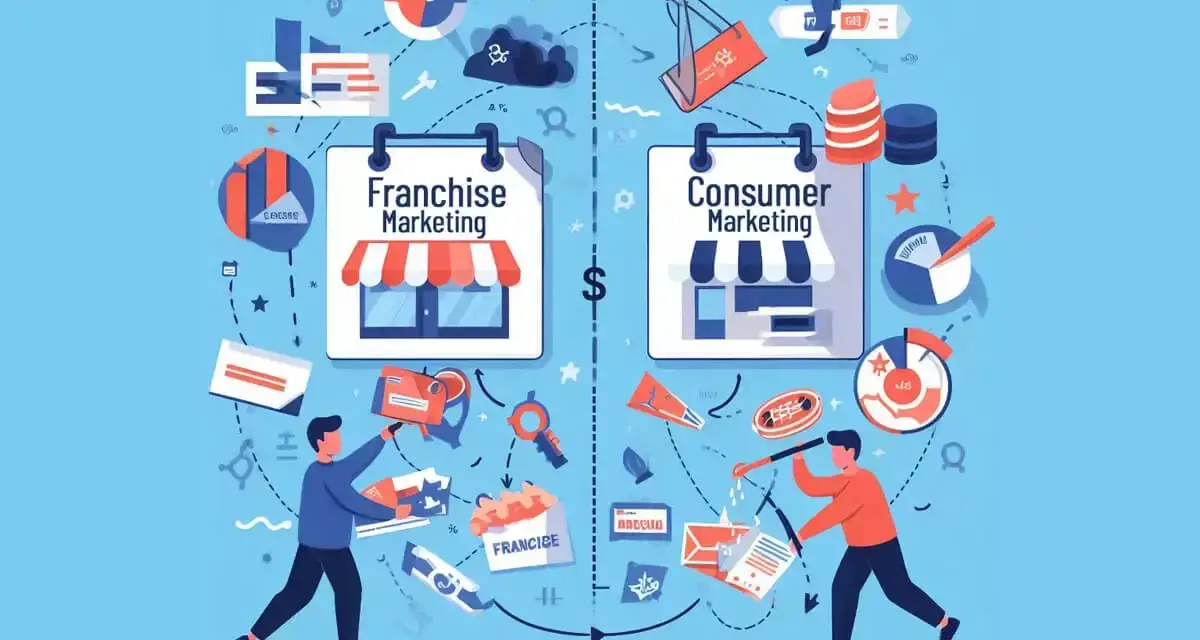The Two Worlds of Marketing
Assume you have just launched a successful business and are considering franchising. You’ve mastered the art of consumer marketing, but as you enter the world of franchising, you quickly realize that franchise marketing is a different beast altogether. It’s like comparing apples to oranges.
But fear not! By understanding the key differences between a franchise and a corporation, you can navigate this new terrain with confidence.
1. Target Audience: Investors vs. End Consumers
Consumer Marketing: Targets the end-user of your product or service. It’s all about creating a desire for the product and ensuring the consumer sees value in it.
Consumer view example: A coffee shop promoting a new flavor of latte might highlight the rich taste, aromatic experience, and limited availability to entice coffee enthusiasts.
Franchise Marketing: Here, the focus shifts to potential franchise owners. These are individuals or entities scouting for profitable business opportunities.
Franchise view example: The same coffee shop, when targeting franchise owners, might highlight its robust supply chain, proven business model, and the comprehensive training it offers to new partners looking to open their own branch.
2. Message Focus: Emotional Appeal vs. ROI
Consumer Marketing: Relies heavily on emotional appeal. Brands often tell a story or create a feeling around their product to entice consumers.
Consumer view example:A skincare brand might emphasize the feeling of rejuvenation, the essence of nature, or the promise of youthful skin to attract its target audience.
Franchise Marketing: The narrative here revolves around tangible benefits, primarily ROI.
Franchise view example: The skincare brand, when communicating with potential franchise owners, might present data on market share, average profit margins, and the success rate of its existing franchise outlets.
3. Channels of Communication: Broad vs. Niche
Consumer Marketing: Utilizes a wide range of channels, from social media to TV commercials, targeting a broad audience.
Consumer view example: A fitness brand running Instagram ads showcasing their latest workout gear.
Franchise Marketing: Often uses niche channels like franchise directories, trade shows, and industry-specific publications to reach a more targeted audience.
Franchise view example: The same fitness brand attending a franchise expo to present its business model to potential franchise partners.
4. Duration and Commitment: Short-Term vs. Long-Term
Consumer Marketing: Often focuses on short-term campaigns to promote a new product or offer.
Consumer view example: A restaurant offering a limited-time discount on a new menu item.
Franchise Marketing: The commitment is long-term, focusing on building and nurturing relationships.
Franchise view example: The same restaurant might offer relevant franchise owners a year-long mentorship program, ensuring they understand the brand’s ethos, operations, and customer service standards.
5. Goals: Sales vs. Partnerships
Consumer Marketing: The primary goal is to drive sales and increase revenue.
Consumer view example: An apparel store might introduce a loyalty program, offering discounts to repeat customers to boost sales.
Franchise Marketing: The focus shifts from mere transactions to building lasting partnerships with franchise owners who will uphold and expand the brand’s reputation.
Franchise view example: The apparel store organizing a franchise owner appreciation event to strengthen relationships and discuss future expansion plans.
By understanding these distinctions, you can effectively market both to consumers and franchise owners. Whether you’re aiming to boost sales or expand your franchise network, the nuances between the two can be intricate and challenging to navigate.
Implementing an effective franchise marketing strategy is another challenge altogether. But you’re not alone in this journey.
How TopFire Media Can Ignite Your Franchise Marketing
TopFire Media is your partner in this endeavor. As a full-service marketing agency specializing in franchise development, they bring a wealth of experience and expertise to the table. With a deep understanding of the nuances of franchise marketing, TopFire Media crafts bespoke strategies that resonate with the right franchisees. Here’s how they can elevate your brand:
Targeted Messaging: They don’t just tell stories; they create compelling narratives that highlight the strengths of your franchise opportunity.
Strategic Channel Selection: It’s not about being everywhere; it’s about being where it matters. TopFire Media identifies the most effective channels to reach targeted franchise owners.
Compliance and Transparency: In the world of franchising, regulations can’t be an afterthought. They ensure that all marketing efforts are in line with franchise regulations, ensuring you’re always on the right side of the law.
Brand Consistency: Your brand is your promise to your customers. TopFire Media works diligently with you to maintain brand integrity across all franchisee operations, ensuring a consistent experience for all.
Ready to elevate your franchise marketing strategy? Don’t navigate the complexities alone. Contact TopFire Media at 708-816-5190 and watch your franchise network ignite!





